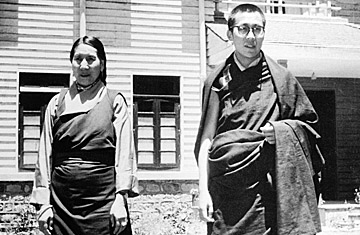
May 28, 1959: Tenzin Gyatso, the 14th Dalai Lama, and his mother, shortly after the Tibetan Buddhist ruler fled his homeland for exile in northern India
(2 of 9)
Aroused Asia. The 1956 rape of Hungary by the Soviet Union did not rouse the frustrated rage in Asia that it did in Western Europe and the U.S. White v. white colonialism does not stir Asians much. But the crime against Tibet has opened many Asian eyes. The independent Times of Indonesia warned that Red China was losing what few friends it had left. From Japan to Ceylon, Asians angrily recalled the fine words of Red China's Premier Chou En-lai at the Bandung Conference in 1955, when he warmly embraced Nehru's Panch Shila (Five Principles) and specifically promised to respect "the rights of the people of all countries to choose freely a way of life as well as political and economic systems." India's press and public demanded that Nehru be at least as forthright in denouncing Red China as he was in denouncing Britain and France during the Suez invasion, and were impatient with his bland impeachments of Peking. In Buddhist Cambodia, a newspaper that often echoes Cambodia's neutralist royal family urged Red China to withdraw its troops from Tibet and prove "that it respects the hopes of all peoples for liberty and self-determination."
Buffer State. Over the centuries, the mountain-locked nation of Tibet has often been overrun by invaders—Mongols, Manchus and Gurkhas, but most often Chinese. Whenever China was strong, it would send a garrison to occupy Lhasa. Whenever China was weak Tibetans would drive the garrison out. In 1904, uneasy about Russian encroachments in central Asia, the British launched an expedition from India and captured Lhasa with little difficulty. To keep each other at arm's length, Britain and Czarist Russia agreed to make a buffer state of Tibet and signed the Convention of 1907 recognizing China's "suzerainty" over Tibet. No one bothered to define suzerainty, nor did anyone consult the Tibetans.
Large chunks of Tibetan territory disappeared. The provinces of Amdo and Kham were taken by China, Sikkim ended up with India, Ladakh went to Kashmir. Today there are more Tibetans living outside Tibet than in it (1,700,000 to 1,300,000).
The Yellow Hat. The nation's sole defense over the centuries was the Three Precious Jewels of Tibetan Buddhism: the Buddha, the Doctrine and the Community. Power lay with the contending monks and noblemen. The Red Hat sect, which allows its lamas to marry, was gradually overborne by the celibate Yellow Hat sect. This was made official in 1557 when a Mongol khan gave the seal of rulership to the leading Yellow Hat monk and named him Dalai (Ocean of Wisdom) Lama. The fifth Dalai Lama is famous for building the vast Potala. He also felt the need to honor his favorite teacher by naming him the Panchen (Teacher) Lama, and put in his keeping Tibet's second largest city, Shigatse. He thus created a rivalry that has plagued Tibet ever since. Generally, the Dalai Lama has had the support of whatever power is ruling in India, and the Panchen Lama of the ruling power in China.
